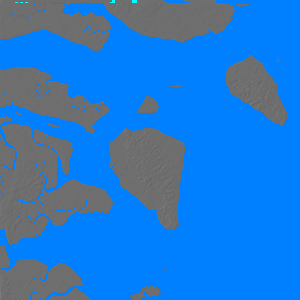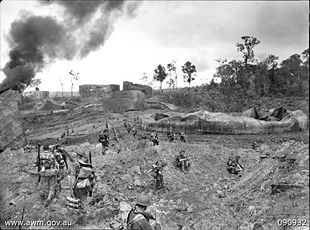![]() The Pacific War Online Encyclopedia
The Pacific War Online Encyclopedia
|
| Previous: Tao'an | Table of Contents | Next: Tarawa |

Tarakan (117.587E
3.312N) was an oil
port on an
island in the Sesayap River delta of east Borneo, with production of about 5.1
million
barrels per year from two fields near the center of the island. Tarakan
measured about fifteen miles (24 km) from northwest to south.
Facilities were limited except for the refinery and four oil loading
piers, which were located at Tarakan town on the southwest coast. There
was a
small, miserable
airstrip about a mile northwest
of the town that
figured prominently in the Japanese
offensive
against Borneo and the Netherlands
East Indies. There was also a seaplane
base with two underground fuel tanks having a capacity of 220,000
gallons each. The interior is heavily forested while much of the
coast is mangrove swamp except
around Tarakan town. The interior is rugged hills reaching to about
100' (30 meters). The population was about 7000 persons.
The island fell to the Japanese on 12 January 1942 and the Japanese immediately moved up elements of the Tainan Air Group to cover further moves south.
Tarakan oil was light sour crude: It contained enough volatile fractions that it could be used as fuel for ships without any refining, but it also contained enough sulfur to embrittle iron boilers. By 1944, the Japanese Navy was sufficiently desperate for fuel that it began using raw Tarakan crude in spite of the risk of serious boiler damage.
First Battle of
Tarakan. The Japanese invasion
force, led by Hirose Sueto,
consisted of
sixteen transports, four minesweepers, and two seaplane tenders carrying 2 Kure Special Naval
Landing Force, 2 Base
Force, and elements of 56
Independent Mixed Brigade (Sakaguchi). Air cover was
provided by 21 Air Flotilla and the
transports were covered by a strong escort of four light cruisers and fifteen destroyers. This force departed
from Davao on 9 January 1942 and
arrived off Tarakan on 10 January. Tarakan was the first major Dutch
territory subject to invasion in the Pacific War, and the formal
declaration of war by Japan on the Netherlands was delayed until the day of the invasion, although the Dutch had declared war on Japan on 8 December 1941.
The delay in the Japanese declaration of war may have been intended to
keep the Dutch from demolishing their oil fields before the Japanese
could seize them.
The Dutch
defenders, consisting of a
single battalion of infantry (VII
Garrison Battalion) plus
some coastal artillery, managed
to sink minesweepers W-13 and W-14
before being overwhelmed the next day. Because the Dutch commander had
already
offered to surrender at the time
the minesweepers were sunk, the
Japanese executed 219 men from
the gun crews, who had not yet received a surrender order.
Seven B-17 Flying Fortresses attacking from Malang encountered bad weather, forcing four of them to turn back. The other three scored no hits.
The invasion force was much stronger than necessary for this operation, but the Japanese intended to continue working the force south to become the Central Force for the invasion of Java, the ultimate objective of the Centrifugal Offensive.

Australian War
Museum. Via Wikipedia
Second Battle of
Tarakan. The island was softened up by RAAF air attacks
beginning on 12 April 1945. The beaches were a considerable hindrance to landing operations,
consisting mostly of soft mud of which just 10 to 15 yards (9 to 14
meters) was exposed at high tide. The difficulties were further compounded by four rows of beach obstacles and numerous offshore mines, including magnetic mines dropped by Allied aircraft to hinder tanker
access to the port. This meant several days would be required to clear
the mines and obstacles, which in in turn meant there could be no surprise. The minesweeper
echelon arrived off Tarakan on 27 April 1945 and swept 44 mines over
the next four days, suffering damage to two motor minecraft. On 30
April, an artillery force was landed on tiny Sadau Island to provide cover for the engineers demolishing the beach obstacles and for the main landings the next day. While covering the engineers, destroyer Jenkins was badly damaged by a mine.
The invasion force, consisting of Australian 26 Brigade, 9 Division (reinforced to 12,000 men), arrived on 1 May 1945 (OBOE I). The Japanese defenders numbered 2100 troops of 455 Independent Battalion and 2 Guard Force. Following the pattern of Japanese garrisons elsewhere in 1945, the defenders put up little opposition to the initial landings. By 1340 the piers were secured and could be used for unloading, which was fortunate, as the falling tide would have prevented unloading over the beaches.
Although the Australians reached the town and airstrip
the day after the landings, it took the Australians another seventeen
days to drive the Japanese offthe high ground north and
northeast of Tarakan town. Some 1000 Japanese in small groups remained at large in
the northern part of the island. Casualties
were 255 Australians killed and 670 wounded. The Japanese suffered 1600
killed and 252 captured,
one of the highest Japanese surrender
rates in the entire war. A few troops escaped the island and made it
clear across Borneo to Brunei Bay.
Another 300 turning themselves in after the general Japanese surrender.
The Australians hoped the oil field would ease the logistics of their Borneo campaign,
but the Japanese so thoroughly demolished the field that it took a year
to bring back into production. The airfield also proved of little
value, its drainage being so poor that it could not be made operational
in time to support the other Australian landings in Borneo.
References
CombinedFleet.com (accesssed 2008-1-7)
The Pacific War Online Encyclopedia © 2007, 2010-2011, 2014 by Kent G. Budge. Index